How to Pilot Handbook
A tool for better public spaces
Gehl — How to pilot handbook 3 Introduction Themes 01 Pilot projects as a planning tool 8 02 Principles for good design 12 03 Strategic thinking and upscaling of pilot projects 16 04 The role of data to provide evidence and ensure impact 20 05 Visioning as an important part of participation 26 06 Organisation and governance 30 How to read the booklet 7 4 8

Gehl — How to pilot handbook 4

Pilot projects can help to reduce barriers between citizens and decision makers, make the goals to improve the public realm more tangible, and be used as test-beds for a wide range of outcomes. Pilots vary in scale, time-frame and typology, but in all cases they are a way to test new solutions at a 1:1 scale out in the streets and public spaces. This 1:1 scale invites residents and businesses to engage in the process of changing their city and to experience their streets as public spaces. Pilots contribute to building momentum and demonstrating project goals in situ.
This booklet summarises key considerations when working in public space and engaging with pilot projects. Many different competencies are needed for pilot projects to have a positive impact on the quality of public space. This booklet presents ideas and tools for how to strengthen a people-first approach to public space design by focusing on the visions and strategies as well as the design process of pilot projects.
Designing good public spaces is not only a question of conception and form, but indeed the ability to be impactful and of strategic importance. With tactics, tools and a small selection of case studies from around the world, this booklet is to be used as a source of inspiration in this endeavour - and can act as a supplement to many other tools and guidelines.
Gehl — How to pilot handbook 5

How to read the booklet
The booklet is structured around a number of themes important to implementing successful public space pilot projects, and provides technical support to do so.
Each of the themes:
• Summarizes common challenges
• Presents key take-aways – ideas and overall suggestions of how to address common challenges
• Provides a short introduction to one or two tools
• Gives a reference to a case study that exemplifies some of the principles mentioned
This booklet is not a design guide in the sense of providing specific design prescriptions, but rather provides tools that can help determine what good public space design can do. While this booklet does not provide an exhaustive list of tools and best practices, it serves as a summary of key principles to get you started.
Gehl — How to pilot handbook 7
Pilot project as a planning tool 01
Pilot projects are a tool for urban transformation and community engagement. They can be used to make the case for change, as a dialogue tool across stakeholders and sectors, to test solutions prior to significant investment, to leverage and highlight unseen potentials of a site, and for early activation and placemaking.
Common Challenges:
Confusion about the goal of the project
False expectations in terms of duration (quick solution? temporary or permanent?)
Pilot projects not creating the desired impact
Pilots as separated projects, and not part of a long term or large scale strategic vision
A pilot project can serve different purposes
1. Catalyst for change
Starting prior or parellel to a long term development. It can be in the form of an installation project, event pilot or program based pilot project
2. Full scale test
A reversible project involving physical change but quicker, more simple and at a lower cost than a traditional project.
3. Demonstration project
A fully implemented design project which functions as a best practice project for future projects or a prototype pilot of a new design solution
4. Engagement & collaboration
Testing new ways to collaborate and engage people in a development process by building trust and sense of ownership
Gehl — How to pilot handbook 8
How To
Tool
Qualitycriteria&guidelines
Pilots as a new way to plan and implement projects
Pilot projects can be used as part of a step-by-step planning process, where testing solutions and refining the result prior to long term investments can help secure the desired long term or large scale impact of the project.
Step-by-step planning as a learning process:
Compared to a traditional (linear) planning process:
The 3 steps of a pilot project:
Measure
Collect data that provides information on what can be tested and has the potential to improve.
Test 1:1
Design a pilot project and implement. Collect data and feedback that can be analyzed and compared with the previous data.
Learn and refine
Use the knowledge from the test phase in the further work, either with the specific pilot project or in other projects or processes.
Gehl — How to pilot handbook 9
erusaeM Ttse Refine DiscardLearn erusaeM Ttse Refine erusaeM Ttse Refine erusaeM Ttse Refine DiscardLearn erusaeM Ttse Refine erusaeM Ttse Refine erusaeM Ttse Refine DiscardLearn erusaeM Ttse Refine erusaeM Ttse Refine Gehl — How to pilot handbook 9
Long time goal Identified need Final product City Time 1.Solution2.Design 3.Implementation Need
1. Measure Stated need Test enifeR Long time goal Final product Time Time Long time goal and vision
for changes? Learnings
3.Implementation changes? Learnings 1. Measure Stated need Test Long term investments 2.Test i n 1:1 .3 enifeR Implement Discardtheproject Change the project Learn
Case Study
Transforming Denver's 16th Street Mall into a destination


10
Street
Before
16th
Mall
16th Street Mall is a mile-long main street and transit corridor in Denver’s historic downtown core. With only 1% of the daily 28,000 pedestrians stopping and staying, the street was underperforming as a public space when the project started in 2014. In collaboration with the City of Denver and the Downtown Denver Partnership, Gehl measured public life, surveyed general sentiment, documented mobility patterns and monitored retail sales, to learn more about the everyday potential of the street.
Gehl mediated the competing interests of the transit operator (RTD) and other stakeholders by thoroughly investigating and creating a new narrative of everyday life on the Mall. A shared point of view was strengthened through walkshops with stakeholders and a series of temporary pilots promoting a common vision through shared experience. The pilot projects allowed the Downtown Denver Partnership to begin a program to bring more people downtown on the weekends and celebrate the Mall as a meeting place. What started out as a one-day test has over the years been expanded to more days, testing different solutions and using the learnings gained to inform a wider development of this part of the city. Read more about the project and find the full report here

11
16th Street Mall Pilot
Principles for good design 02
Pilot projects allow you to test designs and make informed decissions based on what works, and what does not. However, pilots are never one size fits all and the site's context should be carefully considered when designing pilots.
Common Challenges:
Not always clear how to evaluate the design quality of a project
A tendency to focus on design as a visual quality rather than what the design provides
The design of public spaces has to consider different - and sometimes conflicting - local needs
Design solutions that do not maintain well over time
Design tactics & principles
1. Design for human scale & human sense
Remember the eye-level perspective Are human senses being stimulated? Does the design consider the human scale? Social distances
2. Study human behavior - life and form
Study human behavior and let it help drive the design solutions. Monitor over time if behavior patterns change and make it possible to adapt the design solutions.
3. Design for multi-use and inclusivity
Consider how to invite different user groups and build social cohesion with overlap of functions in the same space. Multipurpose, eg. climate adaptation, life cycle of design & cost-benefit analysis
4. Robustness through integrated maintenance & management
Secure budget allocation for maintenance and clarify roles regarding responsibility and ownership, report mechanisms, rules and regulations
5. Be creative and test solutions
Design with both a long term and a short term perspective
Gehl — How to pilot handbook 12 a
How To
Tool
12 quality criteria
This tool emphasizes basic human needs such as protection, comfort and enjoyment. Surveyors assess the quality of a specific place by grading each of the 12 Quality Criteria. The tool can be used as a check-list while planning new public spaces or pilot projects, and as a discussion tool for determining common goals and success criteria. For tools specifically targeted to creating healthy places see the Inclusive Healthy Places Framework
Protection
Without basic protection from cars, noise, rain, and wind, people will generally avoid spending time in a space. Protection from these things is critical for a space to be regularly used.
Comfort
Without elements that make walking, standing, sitting, seeing, and conversing comfortable, a place generally won’t invite anyone to spend time there. Options for play and exercise can also make the space more inviting to people of all ages.
Protection against traffic & accidents — feeling safe
• Protection for pedestrians and cyclists
• Eliminating fear of traffic
• Safe crossings
Opportunities to walk/cycle
• Room for walking
• Interesting facades
• No obstacles
• Good surfaces
• Accessibility for everyone
Opportunities to see
• Reasonable viewing distances
• Unhindered views
• Interesting views
• Easy orientation
• Lighting (when dark)
Enjoyment
Great public spaces tend to offer positive aesthetic and sensory experiences, take advantage of local climate conditions and provide human-scale elements so visitors do not feel lost in their surroundings.
Dimensions of buildings & spaces in observance of the important human dimension in relation to senses, movements, size and behaviour
Protection against crime & violence — feeling secure
• Lively public realm
• Allow for passive surveillance
• Diversity of functions 24/7/365
• Well lit / lighting in human scale
Opportunities to stop & stay
• Attractive & functional edges
• Defined spots for staying
• Objects to lean againstor stand next to
• Facades with good details that invite staying
Opportunities to talk & listen
• Low noise levels
• Public seating arrangements conducive to communicating ‘talkscapes’
Dimensioned at human scale Opportunities to enjoy the positive aspects of climate
• Sun/shade
• Heat/coolness
• Shelter from wind/ breeze
Checklist for urban quality
Protection against unpleasant sensory experiences
• Wind/Draft
• Rain/snow
• Cold/heat
• Dust, noise, glare
• Pollution
Opportunities to sit
• Defined zones for sitting
• Pleasant views, people watching
• Good mix of public and café seating
• Resting/waiting opportunities
Opportunities for play & exercise
• Allow for physical activity, exercise, play & street entertainment
• Temporary activities (markets, festivals, exhibitions etc)
• By day and night
• In summer and winter
Aesthetic qualities + positive sensory experience
• Good design and detailing
• Good materials
• Fine views/vistas
• Rich sensory experiences: trees, plants, water
Gehl — How to pilot handbook 13
Gehl — How to pilot handbook 13
Copenhagen cases
Flexible and multifunctional public space design


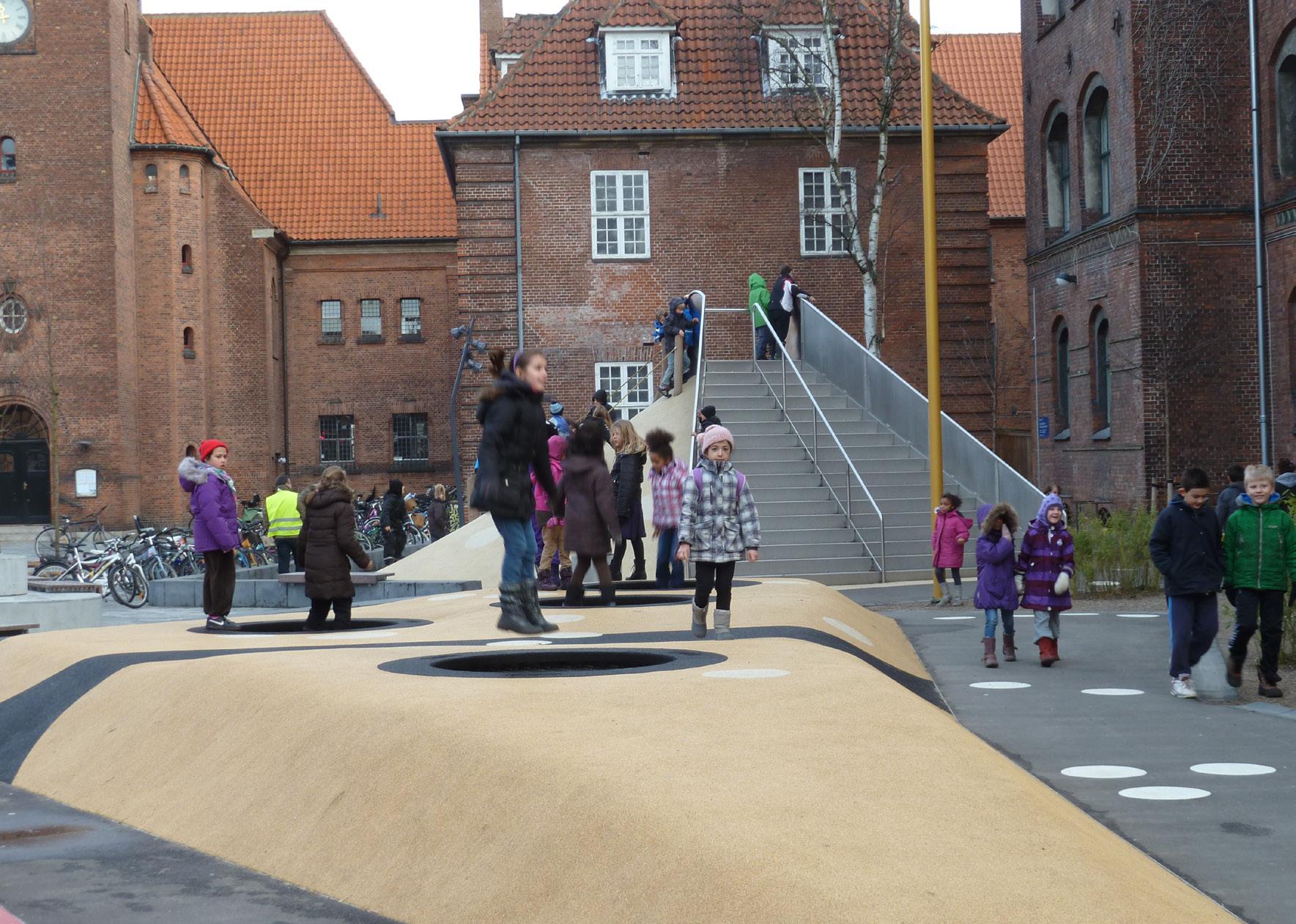
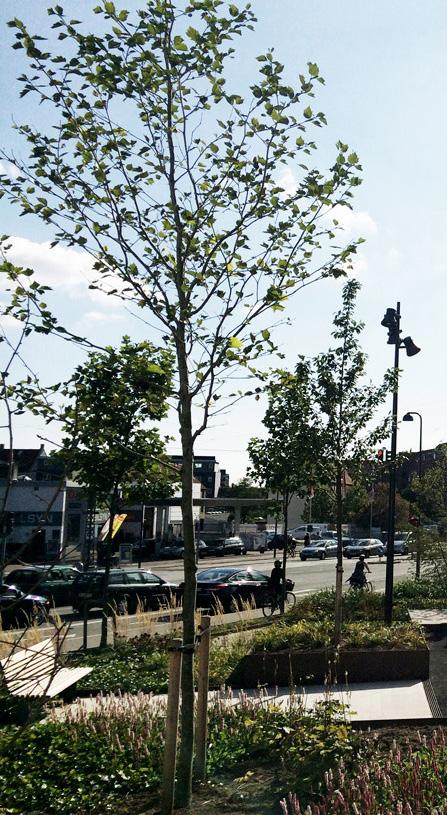 Entrance place to a public function integrates functions with different types of seats for staying programmed space for play. Library Rentemestervej,
Schoolyards in Copenhagen are rarely fenced, and can therefore be used as community places and playground also outside the school's opening hours. Design elements, such as bike parking, mark the border to the street. Guldbergs byplads, Nørrebro.
Centrally located square with different types of seating and objects for sports and play, as well as underground parking. Surrounding functions, eg. a market hall and several schools, spill out on the space and attract different groups to use it. Israels Plads, Central Copenhagen.
Playful
Entrance place to a public function integrates functions with different types of seats for staying programmed space for play. Library Rentemestervej,
Schoolyards in Copenhagen are rarely fenced, and can therefore be used as community places and playground also outside the school's opening hours. Design elements, such as bike parking, mark the border to the street. Guldbergs byplads, Nørrebro.
Centrally located square with different types of seating and objects for sports and play, as well as underground parking. Surrounding functions, eg. a market hall and several schools, spill out on the space and attract different groups to use it. Israels Plads, Central Copenhagen.
Playful
14
The combination activitie
As part of a strategy for creating more public life in the city, the City of Copenhagen has used the city as a testbed for experimenting with public spaces. Special focus has been put on creating good enviroments for children, to attract families to stay in the city, as well as making green spaces available throughout the city. Community parks and places are often programmed with a variety of programs, in order to integrate different user groups.
Recently, the focus has been on creating multifunctional spaces with layered functions that can be flexible for different uses. For example parks, squares and streets designed to hold stormwater in case of a cloudburst, parking is hidden underneath the public space and street furniture is used for marking the border to a place, on top of being a bench and bicycle parking rack.
Read more about Copenhagen's work with climate adaptation in public spaces here

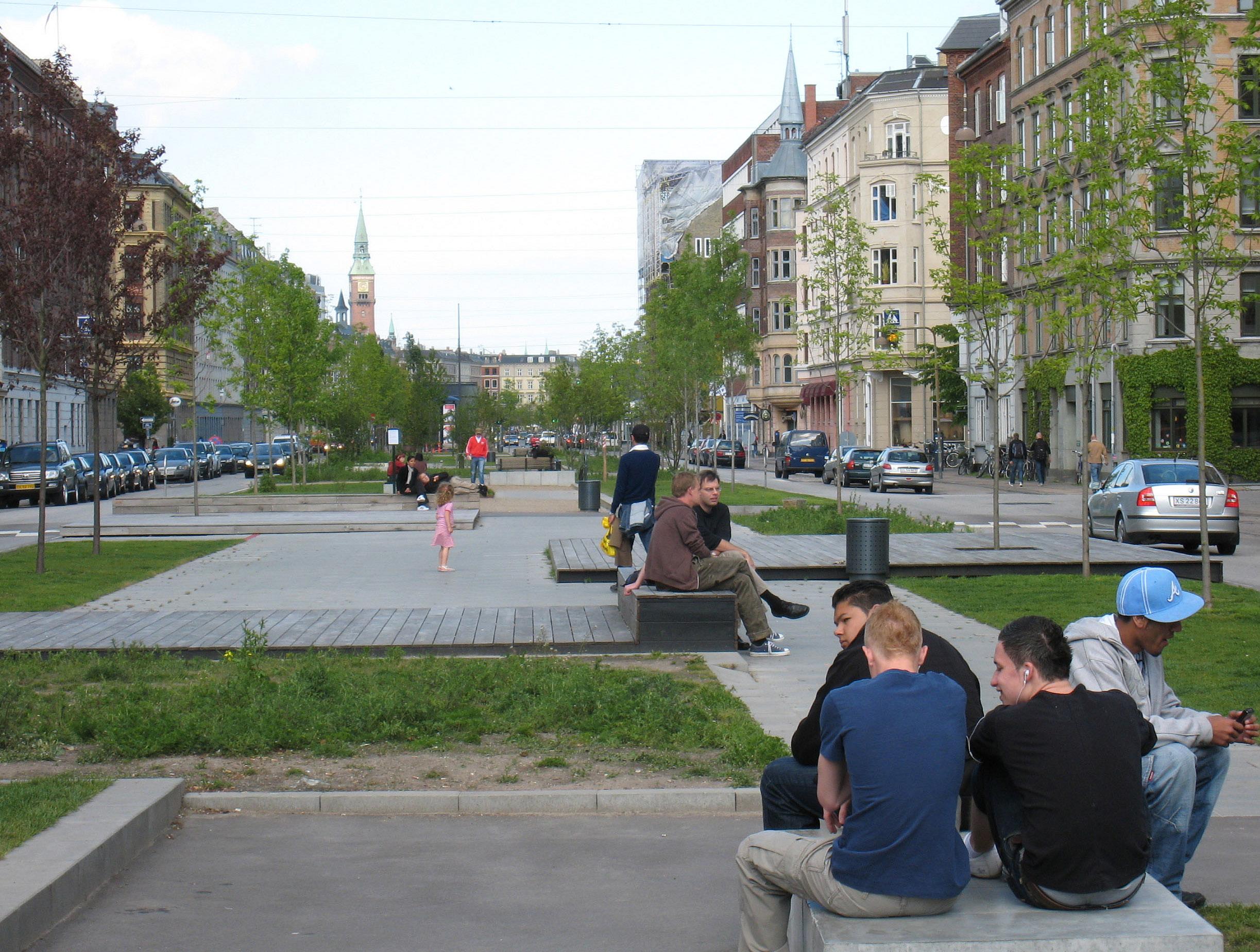
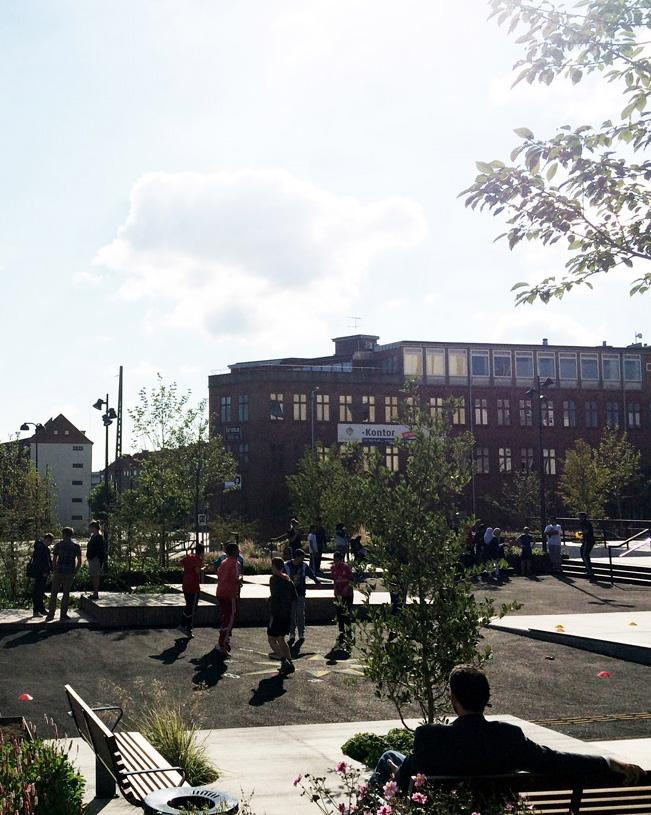
 Linear community park with stormwater treatment. Unprogrammed green space in combination with activities for different user groups. Søndre Boulevard, Vesterbro
Linear community park with stormwater treatment. Unprogrammed green space in combination with activities for different user groups. Søndre Boulevard, Vesterbro
staying and unRentemestervej,
stormwater
Nordvest
Colour and playful elements attracts people of all ages. A variation of staying activities invites different user groups to spend time in the same public space. Superkilen, Nørrebro
design that encourages play and physical activity. combination of movement (bike path) and staying activitie s creates a lively public space. Superkilen, Nørrebro
15
Strategic thinking and upscaling of pilot projects 03
While a pilot can be a one and done type of project, they can also serve as a tool for scaling initiatives across a larger program. To select the right type of pilot project is also a question of prioritization based on your project vision and overall strategy.
Common Challenges:
Local pilot projects initiated by citizens are not embedded in overall strategic plans for a city or neighborhood
Missed opportunity to draw learning for future projects and wider strategies
Pilot projects often have a short time perspective and lack plans for a long term perspective
The values of a pilot are not sufficiently captured
Pilot projects often have a short time perspective and lack plans for a long term perspective
Tactics for creating strategic impact
1.Have a holistic perspective
A pilot project may help solve several issues at the same time
2.Define a clear purpose and goal
A clear purpose (see page 10) with welldefined goals is crucial for withdrawing the right learning and applying the insights in future projects
3.It's a learning process and monitoring and evaluation is key
On-going evaluation of a pilot needs to be considered from the beginning and resources allocated for it to ensure that ideas are scaled up after the pilot
4.Prioritizeate
Assess your opportunities in relation to your overall strategy and desired impact. Start with low hanging fruits, and/or what will generate the clearest impact.
5.Communicate and disseminate
Document the change of a pilot and transfer the knowledge to build more support for future interventions
6.Have an exit plan
Encourage and build a sense of ownership among relevant stakeholders for the next phases of a project, e.g. to
Gehl — How to pilot handbook 16
How To
Tool "How to prioritize"
This simple tool helps prioritize based on 'feasibility & likelihood of success', and 'impact'. To determine the impact requires that a project is assessed in relation to an overall strategy for the city/city area/policy and how it can contribute to that.
Possible barriers may include costs, time, complexity, resistance to the idea.
Using the right metrics
”Fight for it!” Overcome barriers
”Let it go!” Kill your darlings
Using different typologies of pilots, you can understand the pilot project's sphere of influence and how it spans multiple categories:
Regeneration Catalyst
What? Creating new destinations on vacant sites.
Why? To establish a local identity of a long-term project early in the process.
Where? In areas that are being redeveloped in the long-term, but need early activation to gather communities or build support.
How? By creating cultural attractors on vacant sites for varying durations of time depending on the specific context and scale of area.
Process Pilot
What? Citizen engagement process that builds trust, engages new stakeholders and creates solidarity through building together.
Why? To test out new ways of working together to create better processes and outcomes.
Where? In situations that need rethinking of the established engagement and collaboration methods.
How? By consciously and methodically testing, measuring and evaluating a project’s process.
Full scale Test
What? A full-scale, mockup project that aims to test and build familiarity with a new design as close to 1:1 as possible,
Why? To create ownership of a vision before it is fully formed.
Where? Often contested or congested spaces that require buy-in from many stakeholders or from the general public to begin change.
How? By creating a project that is as close to solving the suggested needs as possible with quick, flexible and reversible means.means to create maximum impact.
Insurgent Project
What? An “unsanctioned” project that uses loopholes or spontaneously claimed space, usually unauthorized, to propose a novel urban solution.
Why? To create civic ownership of a space or take initiative when official action is lacking.
Where? On contested, unclaimed or underused sites.
How? Private citizens, ad-hoc groups and community organizations, using simple and cheap means to create maximum impact.
”Just do it!”
Low haning fruit
Opportunities / low barriers
”Raise the bar!”
Add more
Demonstration Project
What? A fully detailed implementation - a flagship project
Why? To build support and creative incentive for even larger scale installations of a similar type.
Where? Usually limited in scale or size, in an area or along a stretch that can serve as an example for similar places.
How? By building a 1:1, fully designed and permanent project with high-quality design and high-quality materials.
Tactical Project
What? A “frame” within which citizens generate content or change limited sites within the urban environment.
Why? To create community stewardship around a project within the context of a larger city strategy.
Where? In places with an existing strong sense of community or with a large body of residents or users that can be engaged.
How? The city facilitates or processes permits and strategic partnerships; citizens take ownership of the actual projects.
Gehl — How to pilot handbook 17
synergy
Hard
Low impact
Easy High impact
Case Study Bueno Aires first citywide strategic plan


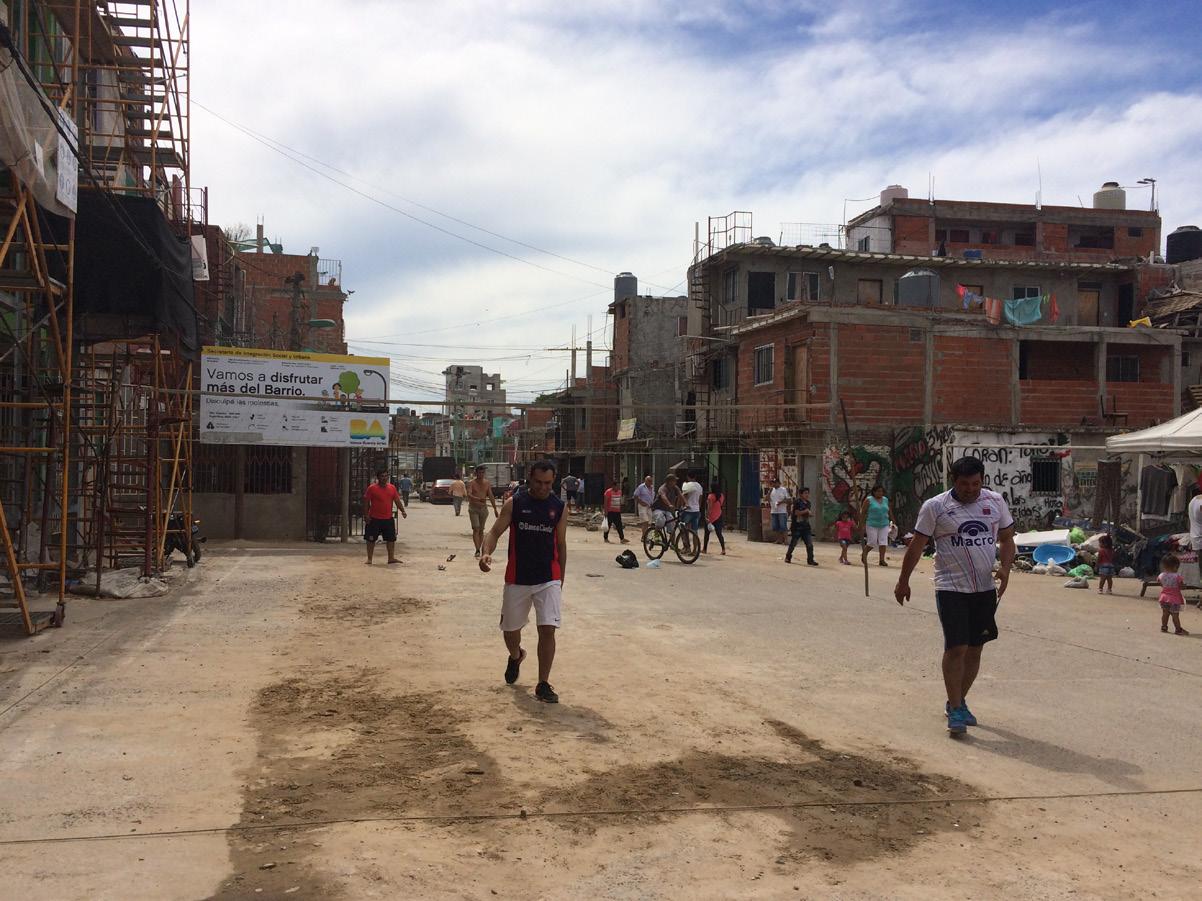

Public space improvements On site engagement 18
Gehl’s approach to citywide strategic planning focuses on improving people’s quality of life, leverages collaboration between government departments to create shared goals and break through silos, and creates a flexible framework with ambitious goals and concrete actions that can be tested and tweaked over time as lessons are learned and cities evolve. In Buenos Aires, Gehl was hired by the City to create Argentina's first ever citywide strategic plan - Buenos Aires Roadmap 2027. Read more about the city-wide strategy here
In parallel with the the development of the citywide strategic plan, Gehl helped the City of Buenos Aires with urban design work in one of seven chosen focus areas - the informal settlement Barrio 31. After studies of the public life and built form, made in collaboration with the city, the need to protect the social fabric that this self-made neighbourhood has generated was highlighted. The focus of upgrading was set on the need for balancing infrastructure and formalization to better integrate the area with the rest of the city, with projects on public space improvements, improved connections and upgraded housing.
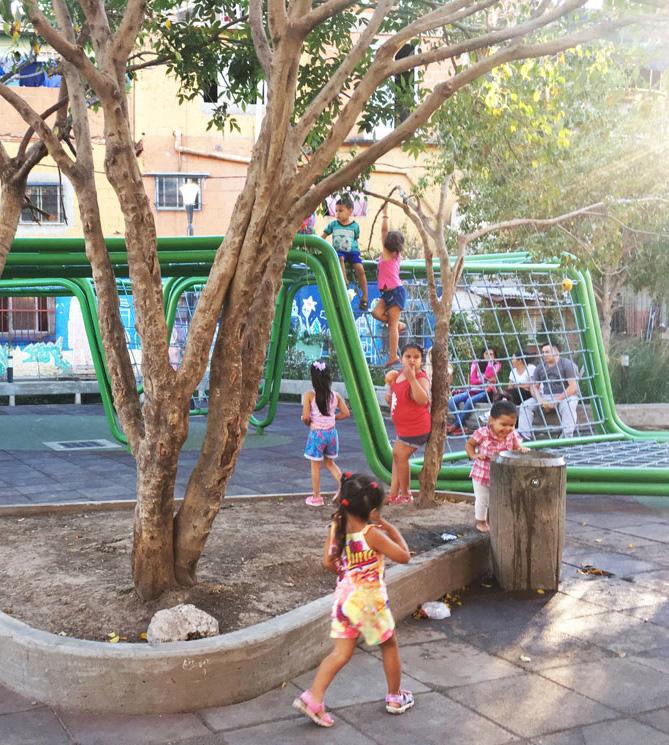
19
The role of data to provide evidence and story telling 04
Common Challenges
Long reports with a lot of data points but little insights and insights that get leadership buy in
Uncertainty: Do we measure the right thing with the data that we collect?
Data points are not comparable throughout the project
Learnings:
• Challenge the type of data collected and introduce more people-centered data points, eg. data on public life (see opposite page)
• Develop new metrics according to the purpose of the project and the overall vision and strategy
• Collect and use data in a purposeful way - and at different stages of a process, both to do assessments but also to follow up on strategies and create meaningful feed-back loops.
• Communication of data is key. Make data compelling and focus on simple and readable maps.
What is the purpose of your data collection?
The types of data is endless and the reasons for collecting it many. Having a clear purpose before starting helps with getting the right set for what you are using it.
Create a proper baseline
Secure evidence based policies
Inform decision making processes
Influence design
Collection of data as a capacity building tool to ensure shared understanding of issues at stake
Predict and inform future scenarios
Change mindsets and bust myths about how places are functioning
Gehl — How to pilot handbook 20
Observations and analysis help us understand public life
The so-called public space public life surveys help to define more people-centered metrics - such as presence of people in the public realm, diversity of user groups, indication of perceived safety (eg. presence of women) , distribution of space between modes etc. These surveys help to better understand the relationship between built form and life. Understanding existing patterns gives valuable information to base recommendations and design proposals on and is a powerful tool to argue for change. More information on how to conduct a survey can be found here


Observation & analysis us understand
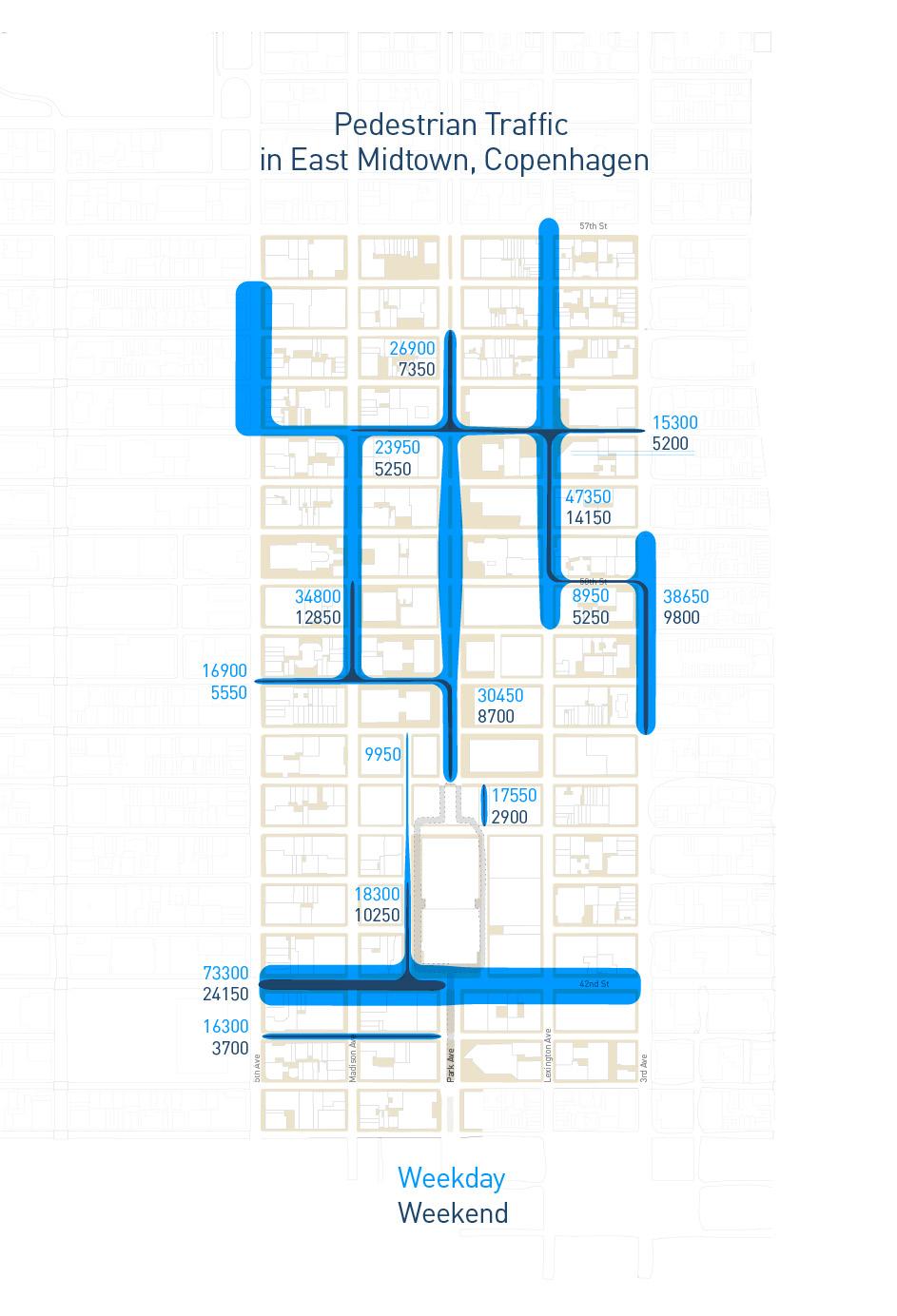
Weekend
Example: Civic Center as experienced by a Woman
Women have a more negative perception of Civic Center to men.
Although 50% of the people moving through Civic Center are women, few of them stop and stay.
This may be because women tend to be more sensitive to issues of safety in public and are deterred from spending time in Civic Center's public spaces because of the ratio of undesirable activities and desirable activities.
Design Challenge
Women are invited to spend more time in Civic Center's public spaces.
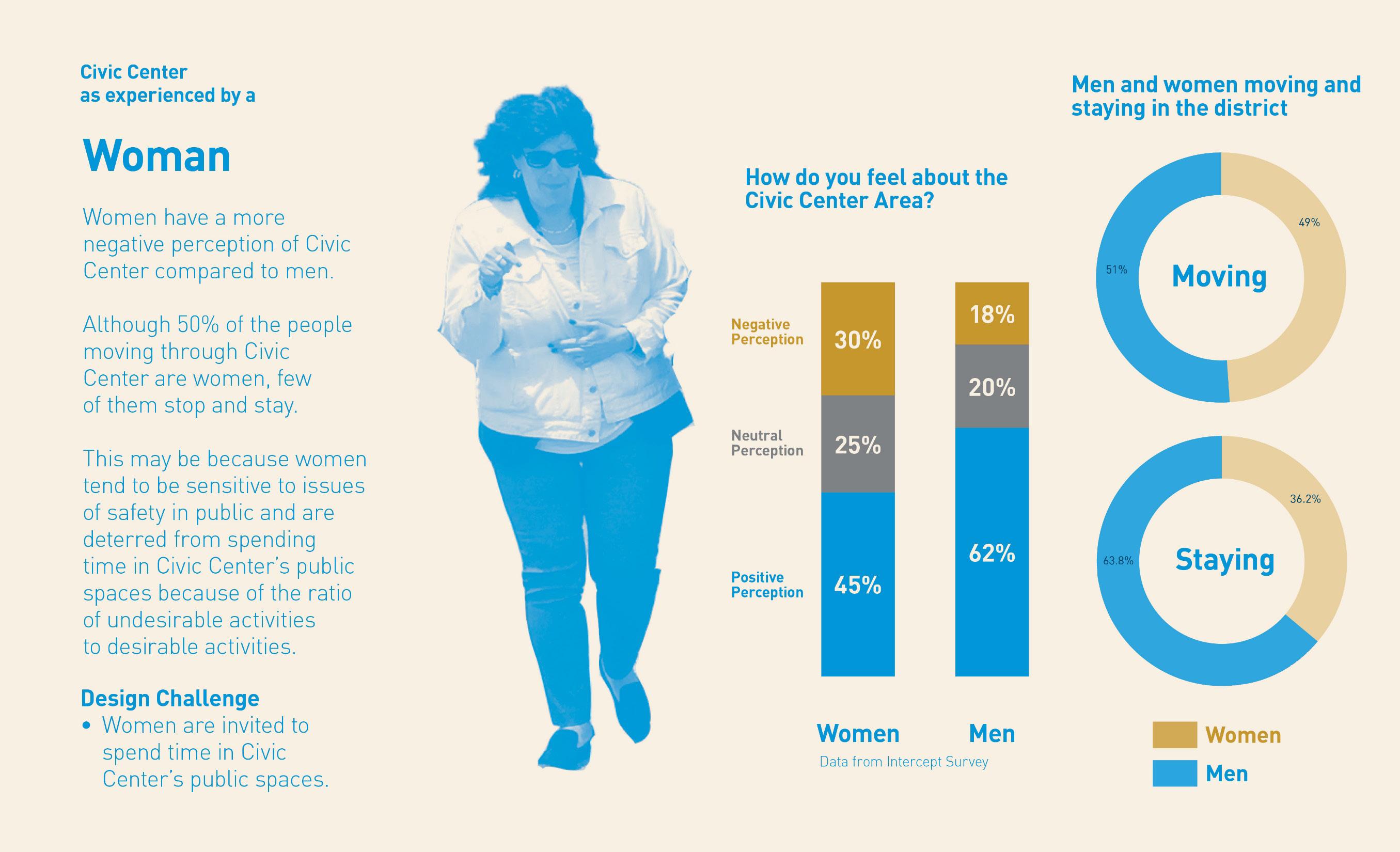
Women and men moving and staying in the area
How do you feel about the Civic Center Area?
Gehl Making Cities for People
Pedestrian Traffic in East
Weekday
Gehl — How to pilot handbook 21
Tool
The role of data to provide evidence and storytelling insights (cont.)
Telling compelling stories about your project contributed to creating a shared understanding of the context among the different actors that are involved in the project process. By telling compelling stories with project data you can:

Why else would you tell data-driven stories?
Common Challenges
Difficulty telling stories that capture important data points and lived experience
Inverstors and believers in the project are not sure where to invest resources
Difficulties in bridging the gap between initial project goals and what was accomplished throughout the course of the project
Learnings:
• Data can create urgency to build support for a project
• Gauge and communicate progress on reaching — or missing — project goals and identify areas for improvement
• Use data to assess impact and tell compelling success stories to the public and other key actors
• Document project process and how it informed project goals
Gehl — How to pilot handbook 22
04
What goes into telling compelling stories?
Make It Stick
Using narrative structure and language to crisply and catchily tell the story
Make It
Quantitative
Analyzing and presenting a mix of before and after quantitative data
Tactics for telling compelling stories:
Make It Human
Integrating quotes, anecdotes, and accessible language
Make It Visual
Illustrating with photos, graphics, and data visualizations

Gehl — How to pilot handbook 23
Tool
Case Study
Public life centered vision for Bogota
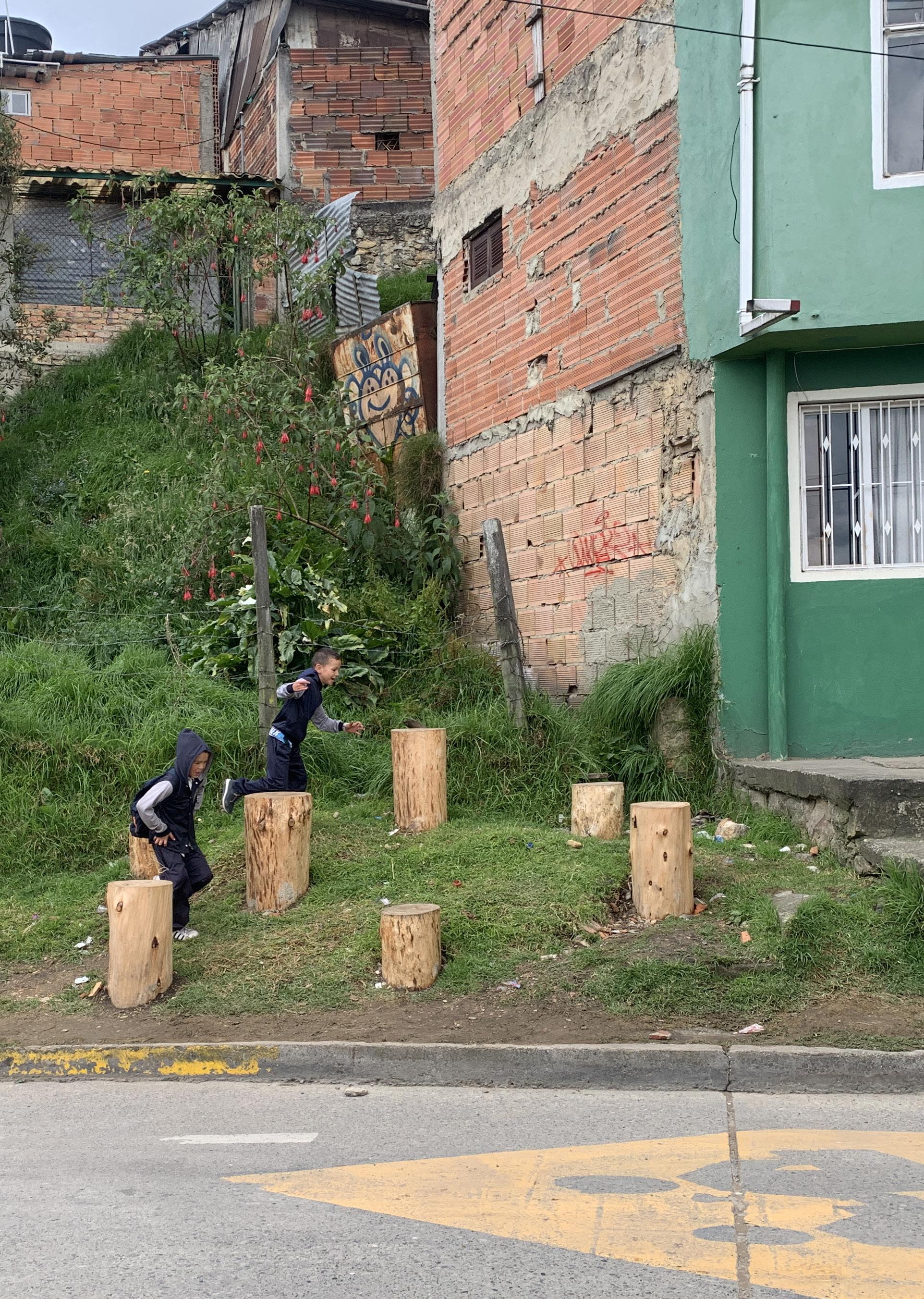
The number of children playing in the public realm increased by 50%
Opportunities to get more involved with the community

New places to sit, socialise, and enjoy the public realm
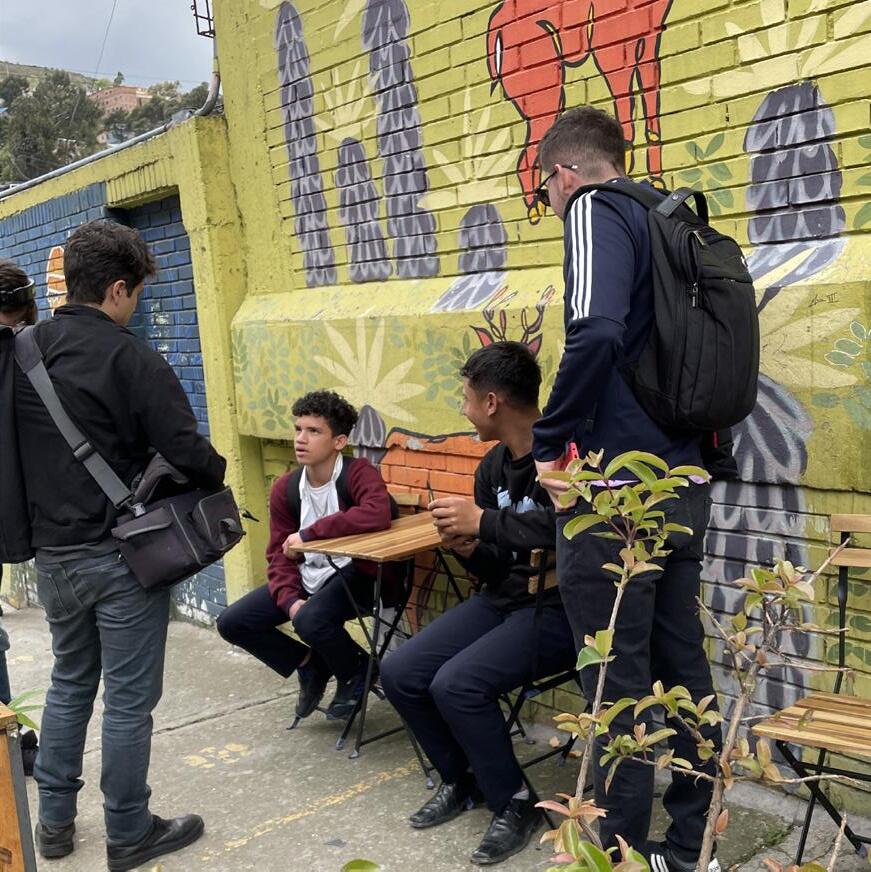

24
BEFORE AFTER
Since 2020, a collaborative initiative has been addressing health risks in five Bogotá neighborhoods, guided by criteria set by the Health Secretary. In 2023, Gehl collaborated with Novo Nordisk and local partners implemented a pilot to support existing bottom-up endeavours in the neighbourhood of San Luis to address food insecurity. The project led to piloting healthy school environments in San Luis, leveraging the public realm to instill healthier behaviors and improve habits. Data played a key role in informing and defining key project goals based on the users needs and behaviours, pilot sites, and finally to evaluate the success of the pilot. The project goals were: increase access to information and healthy food offer habits, boost levels of physical activity in the public realm, and encourage social interaction in the public realm.
After evaluation, we found that the pilot encouraged an increase of healthier eating habits around the school, with food activity going up 240%. Furthermore, people experienced more positive feelings and attitudes towards themseves and felt empowered to introduce changes in their lifestyles. Finaly, play increased in the streets, and the sense of unsagety around the school decreased by 50%. Going forward, local partners will be using the data points and stories from the healthy school environment pilot to scale the project up. Read more about Bogotá healthy school environment pilot here
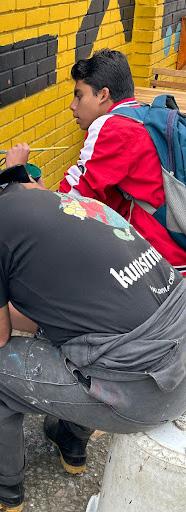
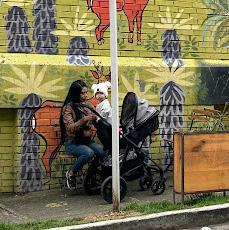
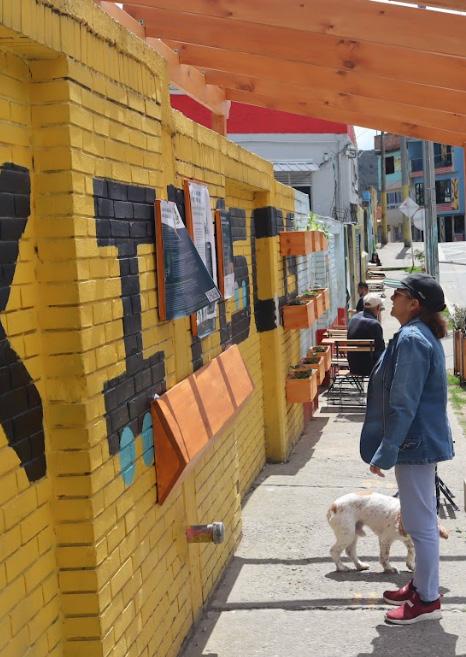
25
More welcoming for parents and their kids
9% more women were seen in the public realm
Visioning as an important part of participation 06
Common Challenges:
Public space projects often lack a shared vision across different stakeholders
Political visions and strategies/ projects are often not aligned
Political cycles and change in government can make it difficult to see a project through
Learnings:
• Long term visions are key to ensure change over time
• Strong visions shared across different interest or political groups are the base from which to align projects and make sure that they all contribute to the same goal
• Overall visions can often be shared by different peopleit's HOW to get there which is the challenging task
1. Shape the vision early in the process
Make sure that the overall purpose/ goal is clear. Shaping the vision helps to both broaden and sharpen the potentials of a concrete project
2. Identify milestones and goals
Make the vision more concrete and actionable by identifying milestones and measures of success
3. Re-visit the vision during a process
Discuss and align the vision along the way as preconditions constantly change
4. Shared vision through shared experience
Need for changes? Learnings
Use different tactics such as walkshops and role play to evoke shared experience
5. Involve the 'no'-sayers
Make sure to involve those not in favor to understand their concerns. Incorporate that knowledge in tactics to tackle resistance
6. Culture is not static!
Work with imagery and showcase examples to illustrate cultural change
Gehl — How to pilot handbook 26 Long time goal Identified need Final product City Time 1.Solution2.Design 3.Implementation
1. Meas Stated need
Tactics for more shared visions
How To
Set intermediate goals to achieve long term goals
Gathering relevant stakeholders early in the process to create a shared vision for the project and together discuss long term and intermediate goals and responsibilities raises the likelihood of a successful project and process. Rather than a fixed plan, a strong vision can help define a flexible framework that combines the short and longterm perspective.
to a traditional (linear) planning process:
Need for changes? Learnings
Creating a common roadmap is a good way to make stakeholders set intermediate goals and share the understanding of what is needed for a project to succeed.
Time Urban transformation Long time goal and vision Qualitycriteria&guidelines asure Test Long term investments 2.Test
n 1:1 .3 enifeR
Discardtheproject
Shared goals
1.Solution2.Design 3.Implementation
Final product
Urban transformation Qualitycriteria&guidelines 1.Solution2.Design 3.Implementation
1. Measure Stated need Test 2.Test i n 1:1 .3 enifeR
Discardtheproject
i
Implement
Change the project Learn
and visions Long time goal Identified need City Time
Need for changes? Learnings An iterative and learning planning process: Set intermediate goals and reach them through pilot processes Long time goal Identified need
City Time
Implement
Change the project Learn Process
Gehl — How to pilot handbook 27
Compared
Long time goal
vision Now 2020 What is the idea, what needs to be done for it to happen? When? Who do we involve, how, when and with what? 2021 2022- Soon Later Urban transformation What? ? ? ? ? ? ? ? ? ? ? ? Who? 1. Measure 2.Test i n 1:1 3 enifeR Long
goal
and
term
Case Study Using People-First Metrics to Transform New York City
DATA COLLECTION (2007) NEAR-TERM OUTCOMES
10% of space was for people, but 90% of users were pedestrians

74% said Times Square improved dramatically
67% said plazas increased time NYC Plaza Program
In Times Square and across the city, cars dominated and people lacked access to open space. Gehl used public space and public life data collection and prototyping to make the case for the pedestrianization of Times Square, and for a rapid expansion of public space in New York City.

28
Final design
In 2007, the New York City administration formulated a strategy for a more people-friendly public realm throughout the city using people-first metrics to figure out where and how to transform public spaces.
With survey sites in four different NYC areas, the people-first metrics enabled the city to see their public realm with a new lens. For instance only 10% of pedestrians were children or seniors, although these groups account for a combined 30% of New York’s population. At Times Square, it became clear that 90% of the space was dedicated to cars, but 90% of the traffic were pedestrians. With these new insights, design outcomes could be developed that dramatically improved public life: traffic speeds across the city improved, pedestrian casualties decreased, businesses saw improved foot traffic etc. The collection of the data helped build support for temporary pilot projects and later permanent solutions.
The testing of pilot projects such as on Times Square also resulted in a city wide program for improving underutilised public space - the NYC Plaza Program, - in order to secure that every citizen lives within 10 minutes walking distance of an open space of quality. Read more about the NYC Plaza Program here and about Gehl's work here
OUTCOMES (2008-2009)
LONG-TERM IMPACT (2008- )

“People love it, reclaiming streets given over to cars but not really used by cars.”
Reclaimed Times Square and neighborhood plazas were good for people, business, and government. The adaptation of urban spaces improved access and attachment to neighborhood open space, drove small business sales, and improved resident perceptions of city government.

The model has transformed the cityscape, withstood political changes, and inspired other cities. Continuing to this day, the program has inspired cities as varied as Mexico City, Bogotá, and Addis Ababa. “It’s now copied all over the country and all over the world,” said Sam Schwartz.
29
POLLY TROTTENBERG, NYC DOT
07
Organisation and governance
Integrated planning with shared visions and goals requires breaking away from the "silo-mentality" often seen within city organisations. Working with cities to identify openings for intersectional collaborations and gathering different stakeholders are methods to start a more efficient and integrated planning process.
Recommendations for how to secure impact
1. Encourage inter-departmental funding
To ensure a broader buy-in, more resources and sectoral integration and coordination
2. Understand the local culture
Identify the appropriate rooms for maneuvre in the local context, eg. the relationship between technical staff and decision makers
3. Identify and use a wide spectrum of capacities
Inside and outside the organisation/ community
Common Challenges:
Pilot projects often have a short time perspective and lack plans for the long term
Unclear roles that create inefficiency
Stranded ideas due to lack of resources or political will
Too much 'silo-planning'
4. Stay involved
Explore opportunities to stay involved and keeping the community engaged to secure the whole life span of a project
5. Combine approaches
Use both bottom-up and to-down approaches to ensure project sustainability
6. Understand the power structure
Who are/who can be the champions? What are the informal power structures?
Gehl — How to pilot handbook 30
A holistic planning approach Organisation
From "silos"
In most cities planning, implementation and management is siloed
Planning Public Works Forestry Dept. of Transportation
How we experience space
Break down the silos for a more holistic planning approach
Food & Beverage
Gehl — How to pilot handbook 31
Case Study Strategic directions for public spaces in Chile
Gehl — How to pilot handbook 32
Gehl helped the Ministry of Housing and Urbanism (MINVU) with a national level strategy for their future work with developing Chile's cities. The report comes with recommendations for the process of how to transform space, and focuses on 5 key areas of action, chosen for the Chilean context: Heritage & Preservation, Sustainable Mobility, Equity & Diversity, Urban Design at the Human Scale and Economic & Cultural Promotion.
The recommendations are now being used in a transformation project of central Valparaiso.
Read the full report here

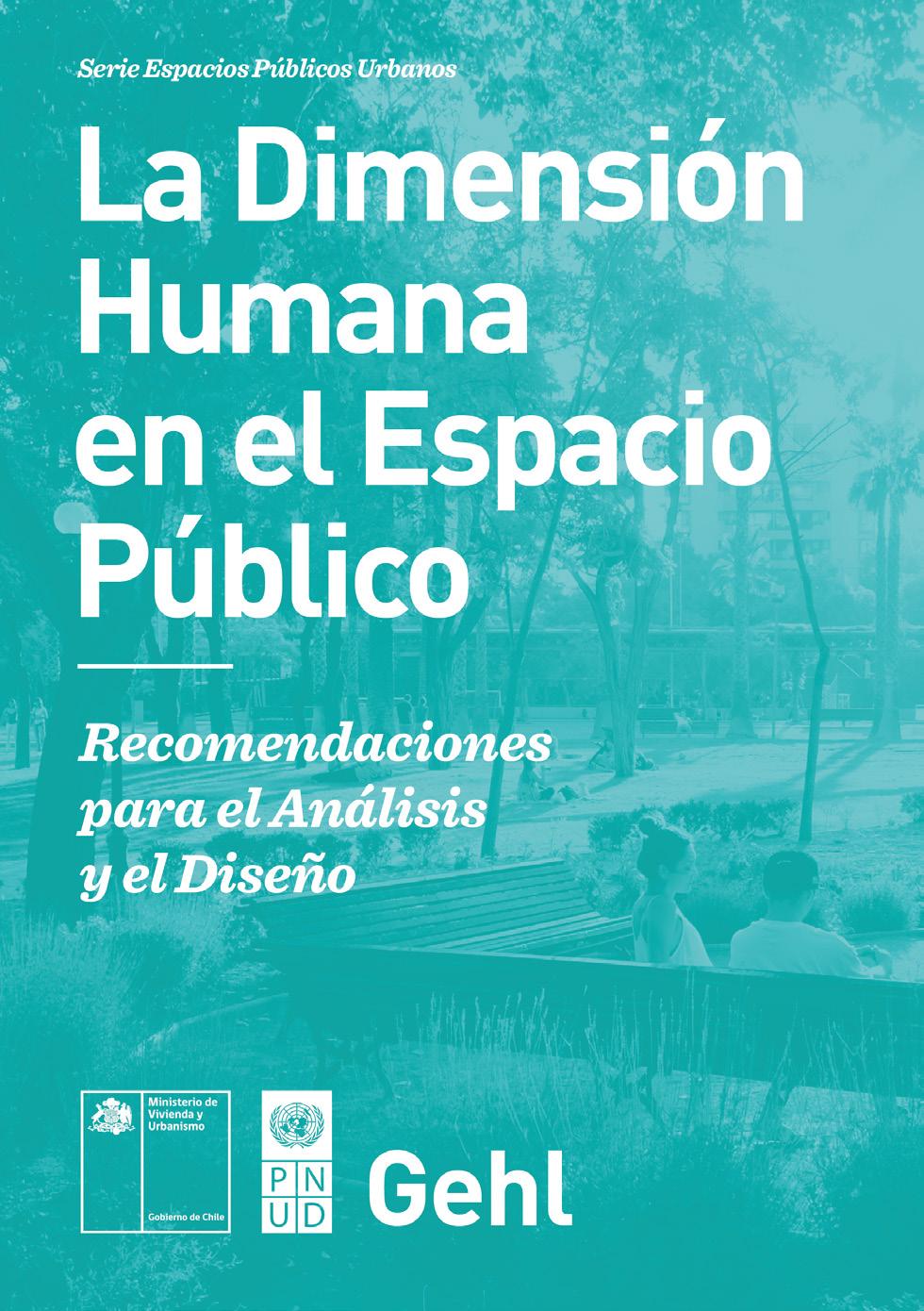
— How to pilot handbook 33
Gehl
Gehl — How to pilot handbook 34









 Entrance place to a public function integrates functions with different types of seats for staying programmed space for play. Library Rentemestervej,
Schoolyards in Copenhagen are rarely fenced, and can therefore be used as community places and playground also outside the school's opening hours. Design elements, such as bike parking, mark the border to the street. Guldbergs byplads, Nørrebro.
Centrally located square with different types of seating and objects for sports and play, as well as underground parking. Surrounding functions, eg. a market hall and several schools, spill out on the space and attract different groups to use it. Israels Plads, Central Copenhagen.
Playful
Entrance place to a public function integrates functions with different types of seats for staying programmed space for play. Library Rentemestervej,
Schoolyards in Copenhagen are rarely fenced, and can therefore be used as community places and playground also outside the school's opening hours. Design elements, such as bike parking, mark the border to the street. Guldbergs byplads, Nørrebro.
Centrally located square with different types of seating and objects for sports and play, as well as underground parking. Surrounding functions, eg. a market hall and several schools, spill out on the space and attract different groups to use it. Israels Plads, Central Copenhagen.
Playful



 Linear community park with stormwater treatment. Unprogrammed green space in combination with activities for different user groups. Søndre Boulevard, Vesterbro
Linear community park with stormwater treatment. Unprogrammed green space in combination with activities for different user groups. Søndre Boulevard, Vesterbro






















